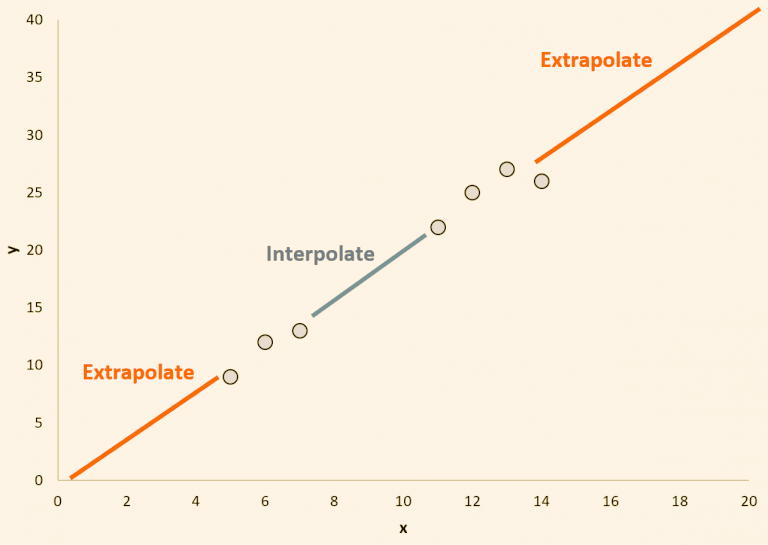Extrapolation in Machine Learning

Machine learning algorithms are designed to learn patterns from data to make predictions or decisions about future data.
Machine learning models, on the other hand, which are trained on a small collection of data, they might not perform well on new data that is beyond the range of the training data. Extrapolation can be used in this situation. The technique of extrapolation involves utilizing machine learning models to generate predictions or judgments regarding data that lies outside the bounds of the training data.
Importance of Extrapolation
Extrapolation is important in machine learning because it enables machine learning models to make predictions or decisions about data that is outside the range of the training data.
This is significant since the real world is stuffed full of data that falls beyond the training data's scope. When used to estimate the price of a house that is twice as large as the largest house in the training data, for instance, a machine learning model that was trained to predict the price of houses based on their size, location, and age may not perform well. Extrapolation is required in this scenario in order to make precise forecasts regarding the worth of the residence.
Techniques for Extrapolation
There are several techniques for extrapolation in machine learning, including:
- A method called Bayesian extrapolation uses Bayesian inference to create predictions about brand-new data that fall outside the bounds of the training data. When the forecasts are imprecise, and the data has a complicated structure, this technique might be helpful.
- Neural networks are a powerful technique for extrapolation in machine learning. They can learn complex patterns from data and can be used to make predictions or decisions about new data that is outside the range of the training data.
- Polynomial extrapolation is a technique for making predictions about fresh data that lies outside the bounds of the training data by extending a polynomial regression line. When the data has a non-linear pattern, this strategy is helpful.
- The process of linear extrapolation entails extending a linear regression line in order to generate predictions about brand-new data that lies outside the bounds of the training data. When the data has a linear pattern, this technique is quite useful.
Advantages of Extrapolation
It has several advantages over other methods of data analysis. Here are some of the advantages of extrapolation:
- Extrapolation may enhance decision-making in a variety of fields, including engineering, healthcare, and finance. Machine learning models may assist decision-makers in making well-informed decisions that result in improved results by accurately predicting future events or outcomes.
- The underlying patterns and trends in the data can be better understood with the use of extrapolation. Machine learning models analyze the relationships between data points to find complicated patterns and trends that may not be visible using traditional data analysis techniques.
- Extrapolation is frequently less expensive than gathering more data. It may be expensive and time-consuming to gather fresh data, particularly for complicated systems or processes. Extrapolation may produce predictions about new data points using current data, which can save time and money.
- Extrapolation frequently results in increased forecast and judgment accuracy. Extrapolation may produce precise forecasts even for data points that are well beyond the range of the training data by employing machine learning models that can recognize patterns in the data.
- One of the primary advantages of extrapolation is the ability to make predictions about data that is outside of the range of the training data. This allows machine learning models to make predictions or decisions about new and previously unseen data, which is essential in many applications.
Challenges in Extrapolation
Extrapolation is difficult because it calls for machine learning models to anticipate or decide on data that lies outside the bounds of the training data. This is difficult because machine learning models may not be able to generalize well to data outside of their intended range, which is meant to discover patterns from data inside a given range. Extrapolation in machine learning is complicated by a number of issues, such as:
- Machine learning models can generate predictions or conclusions that are distant from the actual values, which is known as extrapolation error. When the machine learning model struggles to generalize data accurately beyond the scope of the training data, this happens.
- When machine learning models are overly simplistic and unable to accurately address the complexity of the data, underfitting occurs. When the model is utilized to generate predictions or judgments regarding fresh data that is outside the bounds of the training data, this might lead to subpar performance.
- When machine learning models are overly complicated and are taught to fit the training data too closely, overfitting occurs. When the model is utilized to generate predictions or judgments regarding fresh data that is outside the bounds of the training data, this might lead to subpar performance.
- When machine learning algorithms generate judgments or predictions that are skewed toward the training data, this is known as extrapolation bias. When the machine learning model struggles to generalize accurately to data beyond the scope of the training data, this happens.
Example of Extrapolation
Output:
Value of y at x = 2.1 : 3.6071428571428577
Conclusion
In conclusion, extrapolation is an important technique in machine learning that involves making predictions outside the range of the input data. Extrapolation is useful when we need to make predictions about new data that has not been previously observed. It can be challenging because it requires the machine learning model to generalize its learning to unseen data. To avoid overfitting and deal with outliers, appropriate regularization, and robust techniques should be used. Neural networks are a popular method for extrapolation, particularly for image recognition and natural language processing tasks.
|

 For Videos Join Our Youtube Channel: Join Now
For Videos Join Our Youtube Channel: Join Now










